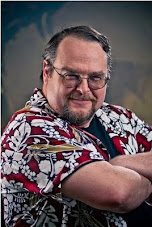My Macintosh is confused, and I am not much better at the moment.
I have a G4 tower, an ancient machine by today's standards, and it has served me well. There have been occasional bugs and crashes, but it has been a Volkswagon of a machine - solid, dependable, and reliable.
So this weekend, when it started up and showed flashing question marks instead of an startup volume, I knew I was in trouble.
Now, earlier in my life, this would be cause for complete panic as opposed to mild concern. We have a multi-machine household, so I got online with my PC and found the apple help site (which would have been unreachable if I had only the sick machine). It listed a few options to try before calling in the pros. First of these involved "reinserting the OS X install disk". The OS X install disk. Right.
Which I could not find anywhere in my office.
Mind you, my office is a bit of a disaster area. Disks from projects four years ago. Boxes of stuff from previous gigs. Yellow legal pads filled with notes, which I neither want to ditch or save. A limbo of knowledge, that is my office.
I spent most of Sunday looking for the disks, to no avail. I found VPN Disks for a Magic: The Gathering project that I worked on five years ago. I found the starter disks for my Mac IIvx, which I no longer HAVE (oddly, I did not throw them out). I found my unemployment benefit information. I found several earrings (all mine). ( found the pitch for a horror game WotC was going to do. I found more pens than I ever thought I could smuggle from various workplaces (and spent a half-hour seeing which ones worked and which ones didn't). And I found paperwork that may/may not have been important.
What I did not find were the startup disks. I know the G4 is now a "Legacy machine" which means that if I need to get it repaired, it will be a major process. Barring that, getting the data off the machine is a priority, as it includes all my email addresses and story ideas. In the meantime, I have the PC, but I use that in the office, and try to keep the two worlds apart from each other.
Sigh. Not panicking yet, but Sigh.
More later,
The Cat Report
-
Glad to learn that Baseball has gone to his new home and by now is getting
to know his new people.
The cat room now has three cats: senior cat Bettie...
6 days ago






